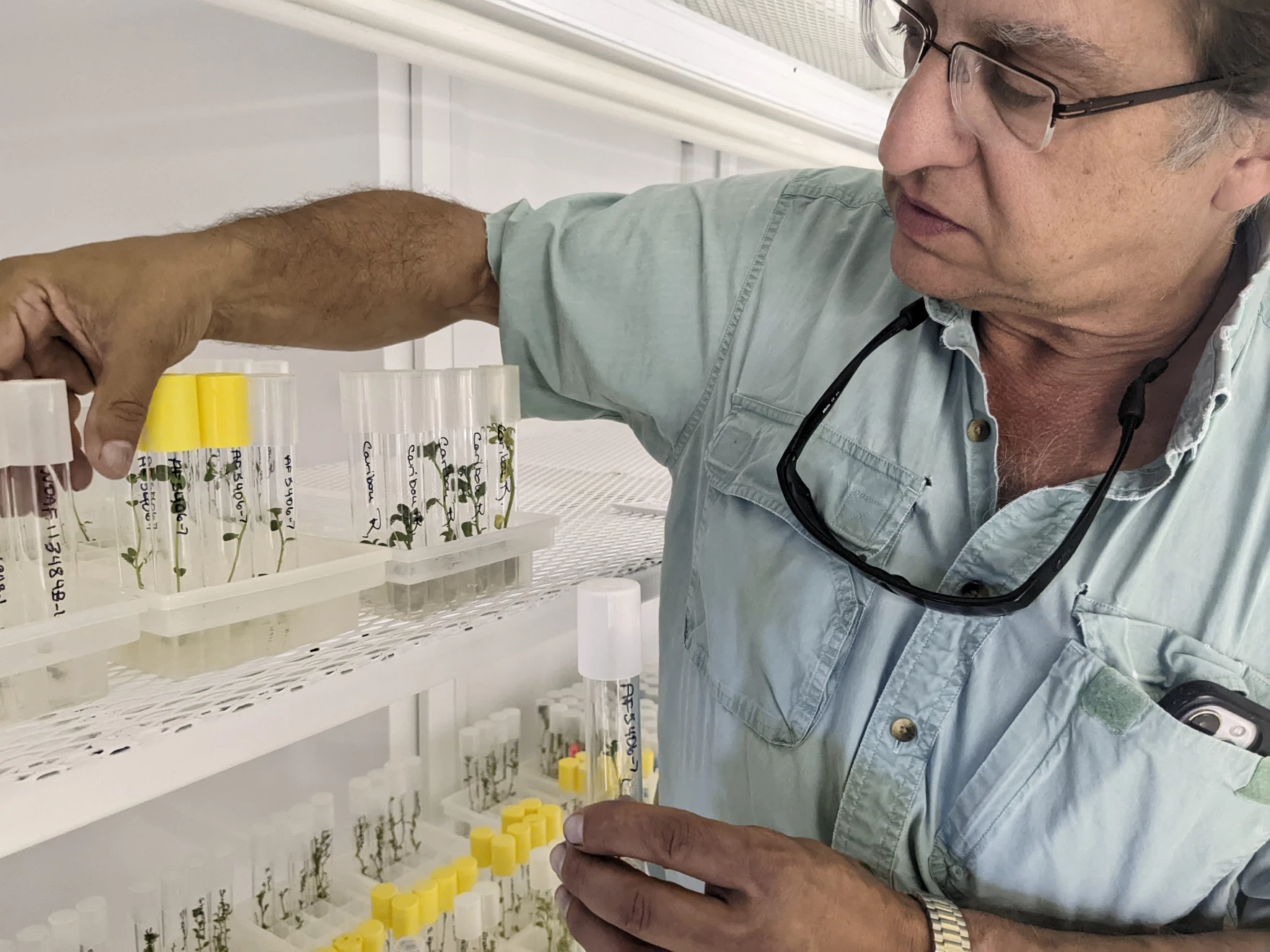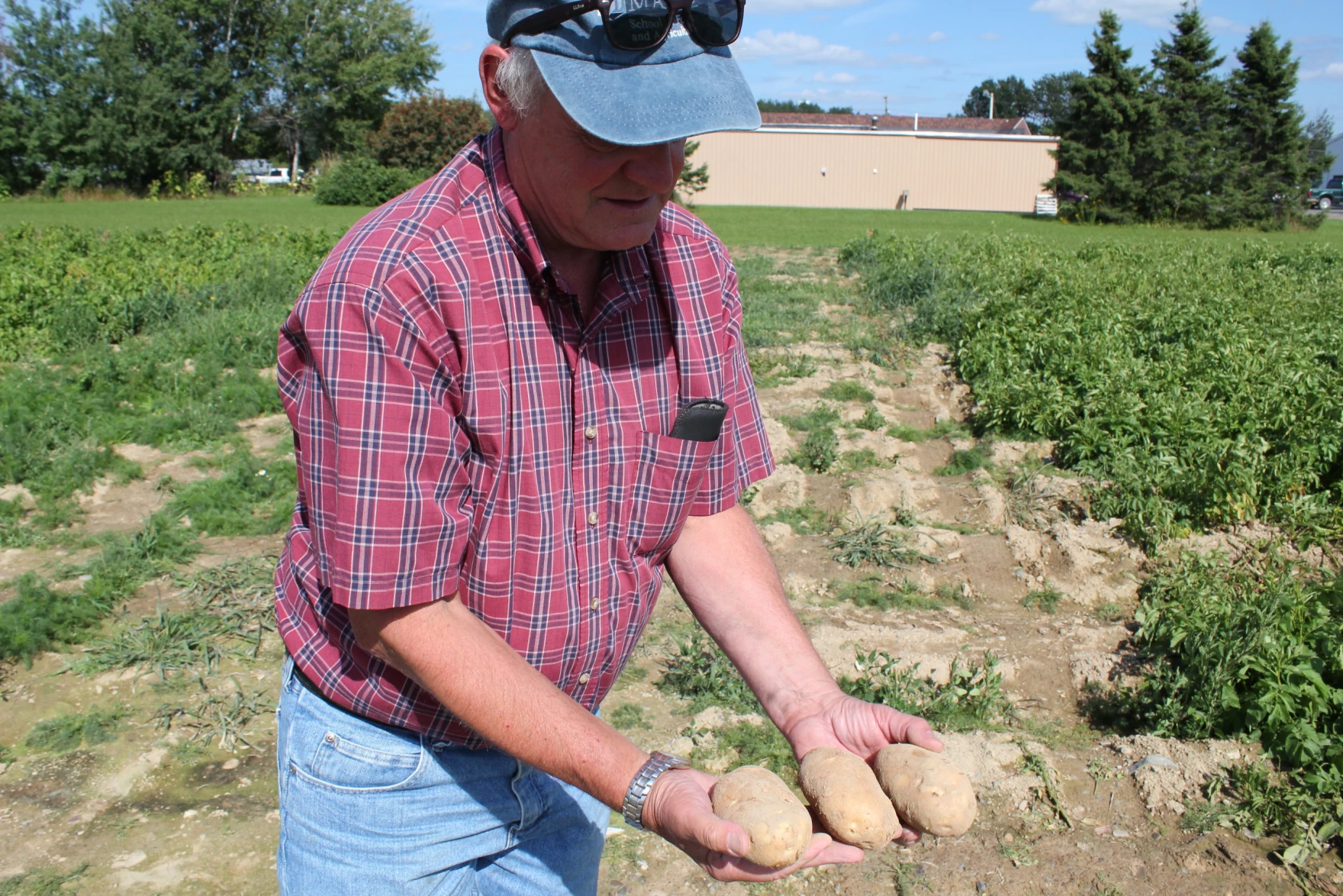Maine farmers hope that breeding a better potato can help the industry deal with a warming climate

Daniel Corey shows off potato plants raised inside his lab and greenhouse in Crystal, Maine. Corey works with companies and researchers like Greg Porter on new potato varieties. (Robbie Feinberg/ Maine Public)
From his pickup truck, Robbie Irving points to a wide irrigation system providing water to hundreds of acres of plants on the Caribou potato farm that his family has harvested since 1936.
Irving’s grandfather started on the system decades ago, and Irving said it’s proved to be vital as temperatures in Aroostook County, Maine, have gotten hotter and drier.
“All his life’s work was building pond after pond after pond. He could almost see the future of this thing — that we were gonna need irrigation,” Irving said.
That need was especially acute two years ago, when the county experienced a severe drought. While potatoes are Maine’s most lucrative crop, with a harvest valued at more than $200 million last year, many farms struggled in 2020.
“My uncle described it as putting a band aid on a bullet hole, so to speak,” Irving said. “No matter how much water you pump, it’s not going to do the job that mother nature can provide for you.”
This story is part of Maine Public’s series “Climate Driven: A deep dive into Maine’s response, one county at a time.”
Don Flannery, the executive director of the Maine Potato Board, said the drought was a wake-up call for a lot of growers who realized they need to prepare for extreme weather.
“I think it got a lot of growers’ attention,” Flannery said. “I mean, we pretty much dug just a little over half a crop in 2020. I mean, it was dry.”
Flannery said in general, the milder winters and hotter summers haven’t been all bad for growers. In fact, some say they’ve helped lengthen the season a few days, leading to even more productive harvests.
But Flannery said growers are taking steps to adapt to the heat, including rotating crops to reduce the stress on the soil. And Flannery estimates that about a third of Maine’s potato crop now receives supplemental irrigation, which is a lot more than just a few years ago — but that costs money, which can be prohibitive for some.

45,000 different varieties of potatoes are grown in a greenhouse at a Presque Isle research farm operated by the University of Maine’s Greg Porter. Each variety will be planted in a nearby field. (Robbie Feinberg/ Maine Public)
“So, you know, it’s a real balancing act,” Flannery said. “I don’t know if anybody’s got it figured out. But if they have, they’re not telling me.”
One of the biggest tools that the industry sees as a way improve crop resilience can be found at a Presque Isle research farm operated by the University of Maine, where Greg Porter leads the university’s potato breeding and variety development program. One of the major goals, Porter said, is to create a tasty but stronger, more resilient potato.
“So whether it’s high temperatures or excess moisture, it’s a crop that can be greatly affected by [those factors],” Porter said. “And it’s also a crop that has many insect and disease pest challenges that are also climate linked.”
To build a better potato, Porter and his team cross-pollinate different potato varieties with specific, desirable traits. The team will then raise each of the 45,000 individual varieties resulting from those combinations each year in a greenhouse, then plant them in a field.
Later, Porter will walk through the field, row by row, to see how each one of the 45,000 varieties has fared.

Greg Porter shows off potatoes grown at the Presque Isle research farm, in which Porter’s team works to produce the next generation of potatoes. (Robbie Feinberg/ Maine Public)
“At the end of the growing season, we put those all out on the ground, and select the ones that have the most desirable appearance, freedom from disease, that sort of thing,” Porter said. “Just visual selection.”
Porter ultimately chooses about 1,000 of those varieties to plant the following year. By year three, the plants are whittled down to about 300, and those get sent to farms in places like North Carolina and Florida, with warmer climates that are similar to what Maine’s might look like in the future.
“Hotter days, hotter nights, sometimes more difficulty with pests,” Porter said. “So it’s a way that we can field select for greater stress tolerance.”
But finding those desirable potatoes is a process Porter said can take a decade or longer. Still, the process has already led to new varieties that have helped some farmers to adapt and grow their businesses.
At his farm in Caribou, Irving walks through a giant packing facility he recently constructed to hold one specific potato variety: the Caribou Russet.

Farmer Robbie Irving stands inside a packing facility created for the Caribou Russet, a variety of potato initially created on the UMaine research farm nearby. (Robbie Feinberg/ Maine Public)
“And this is a direct result of all of Greg Porter’s hard work. This packing facility was designed specifically for the Caribou Russet,” Irving says.
The new variety got its start on the research farm run by Porter, and was released to the public in 2015. Irving raves about the potato: good taste, nice color and good for frying and mashing.
And importantly, the potato is also resistant to drought. That’s helped Irving’s farm to keep up production, even in drier weather. Add it all up, Irving said, and it’s been a hit, with customers clamoring for it in grocery stores across New England.
“So all these people were coming in, emailing us, and specifically they wanted Caribou Russets. They didn’t want anything else. They wanted Caribou Russets,” Irving said.
Irving says that kind of success gives him faith that, with a little help, growers can continue to prosper, even as weather patterns change.
